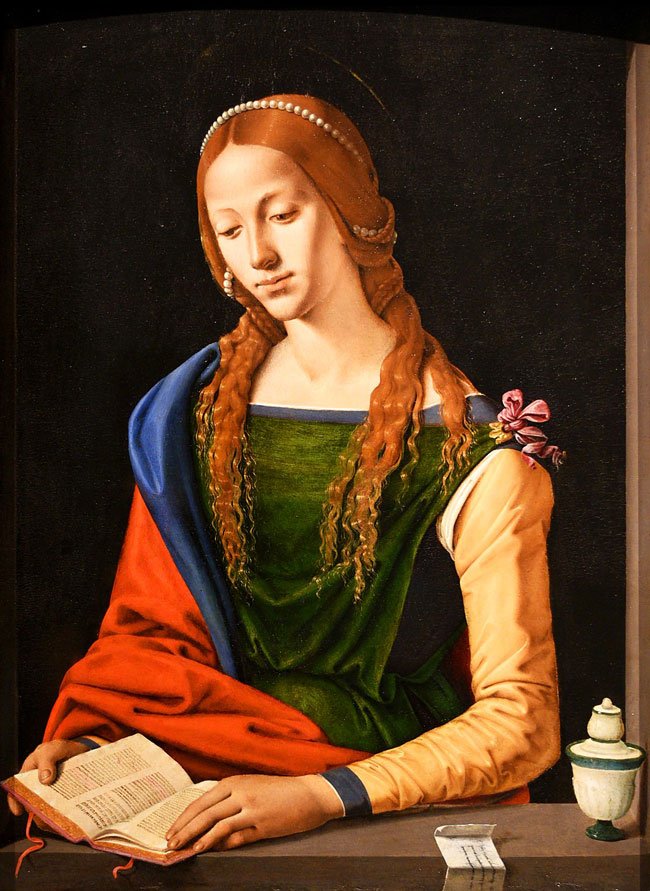Mary Magdalene Speaks

Be on your guard so that no one deceives you by saying, ‘Look over here!’ or ‘Look over there!’ For the child of true Humanity exists within you. Follow it! Those who search for it will find it.
Go then, preac[h] the good news about the Realm. [Do] not lay down any rule beyond what I determined for you, nor promulgate law like the lawgiver, or else you might be dominated by it.”—Gospel of Mary
Mary Magdalene has been an enigmatic and controversial figure throughout the history of the Christian Church. She has also always been equally popular and now she is becoming even more so. She has been portrayed as a prostitute and Apostle to the Apostles, a redeemed sinner and the Bride of Christ.
The Gospel of Mary is a long-lost piece of early Christian writing, probably written (we do not know by whom) in the second century A.D. It came to light in an antique market in Egypt in the late 19th Century. In it, Mary Magdalene is framed as the only disciple who truly understands Jesus’ message, which puts her in direct conflict with the apostle Peter, the ultimate leader of the emerging Christian Church.
The message Mary offers from Jesus in the Gospel of Mary certainly contradicts what eventually became Christian orthodoxy. Rather than a "Son of Man," here Jesus speaks of the "Child of True Humanity." Rather than a Kingdom arriving with the Second Coming, he says this Child of True Humanity is in each of us and those who search for it will find it. He also warns against laying down rule and law, “or else you might be dominated by it.”
It seems to me that the Gospel of Mary actually predicted exactly what happened. By 325 at the Council of Nicaea, the establishment of Canon Law was well underway. The Gospel of Mary, and many other texts espousing a more mystical, direct communion with the Divine, minus intermediaries such as priests or popes, were in wide circulation in the early years of the church. Suddenly they were labelled heretical and excluded from the official canon. It was also established that only men could be church leaders, a jarring departure from the beginnings of Christianity when both women and slaves held positions of power in many Christian churches.
The rediscovery of this side of Christianity, so long suppressed, feels to me like a cool rain after a centuries-long drought. And Mary Magdalene is at the heart of it. Many scholars believe that it was Mary’s enormous influence and power that lead to her being erroneously labelled a prostitute for hundreds of years. And it was also the reason that love and veneration of her were in the end even more persistent. And now Mary (like so many aspects of the Divine Feminine) is back. What does she have to say to us, the people of today, Christian and non-Christian alike? Perhaps she holds a key to a better future, a future we have been denied for two thousand years—but no more.
Sources:
The Gospel of Mary of Magdala: Jesus and the First Woman Apostle, translation and historical analysis by Karen L. King, 2003
The Meaning of Mary Magdalene: Discovering the Woman at the Heart of Christianity by Cynthia Bourgeault, 2010
Lindy Gifford is an artist, photographer, graphic designer, creative coach, and writer, ordained an interfaith chaplain in 2015 by the Chaplaincy Institute of Maine (ChIME). A life-long Unitarian Universalist, she is rooted in daily interaction with and connection to the Earth and Creation, as well as the Christian and pre-Christian heritage of her ancestors. She is the author of the Doodle-ography Journal. Her spirit-based practice as a creative coach and publishing consultant is Manifest Identity. Lindy lives on and learns from the Damariscotta River where she and her husband Steve raised two shining daughters.
Image: Mary Magdalene by Piero di Cosimo (Wikimedia Commons)
